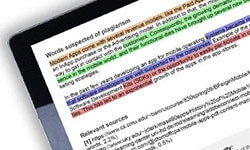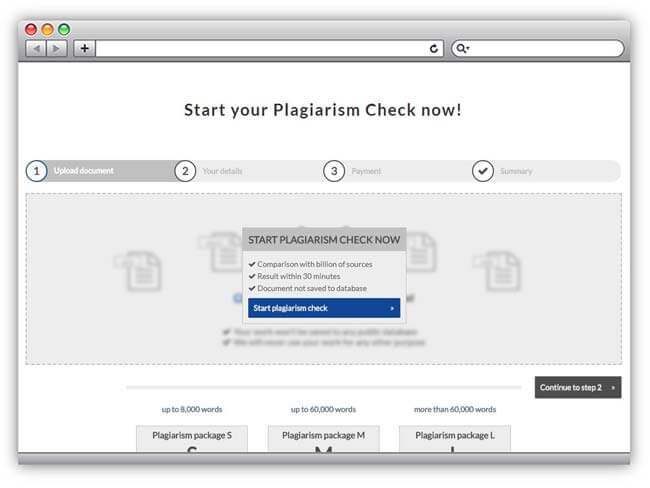
Plagiarism represents one of the gravest offenses in academic writing, referring to the act of presenting someone else’s ideas, intellectual property, or work without proper credit, i.e., as their own. Among merely copy-pasting, it surrounds a variety of behaviors from passing someone’s work as their own to paraphrasing without properly attributing a used source. Committing plagiarism minimizes the academic integrity of the process, as well as, negatively impacts the credibility and transparency of the original author, which makes it crucial to avoid in academia.
Definition
Plagiarism is the act of passing off someone else’s work as your own. This can involve copying passages verbatim, paraphrasing another author’s ideas, or simply using someone else’s research without giving credit. This is considered a form of cheating, and it can lead to serious penalties.
Plagiarism Checker in only 10 min. Play it safe!
Play it safe. Leave nothing to chance!
Why plagiarism is wrong
There are a number of reasons why academic cheating is such a serious issue. First, it represents a direct violation of academic honesty. When students submit work that is not their own, they are cheating both themselves and their instructors. Second, it can lead to the dissemination of inaccurate information. If students copy and paste from sources without carefully verifying the accuracy of the information, they may unwittingly spread false or misleading information. Finally, cheating undermines the integrity of an institution. When students cheat, they damage the reputation of the university and make it harder for honest students to succeed.
6 types of plagiarism
-
Global plagiarism
This is the most blatant form of plagiarism, and it occurs when a student copies an entire paper or significant portions of a paper without crediting the source. -
Verbatim plagiarism
This refers specifically to copying word-for-word from a source without using quotation marks or crediting the author. -
Paraphrasing plagiarism
It occurs when a student rewrites someone else’s ideas in their own words without giving credit to the original author. -
Patchwork plagiarism
This occurs when a student combines bits and pieces from multiple sources into a single paper without properly citing the sources. -
Self-plagiarism
This happens when a student submits their own previously published work as new, without disclosing that it has been published before. -
Non-textual plagiarism
This includes any ideas or materials that are borrowed without giving credit to the original source. This can include things like course lecture notes, images, videos, and ideas from books or articles.
How plagiarism is detected
There are several ways to detect plagiarized content. One common method is known as text-matching using plagiarism checkers. There are a number of different factors that the checker will take into account, including the number of sources that are used, the similarity of the sources, and the overall length of the work.
In general, these tools will produce a report that highlights any instances of possible plagiarism. These reports can be invaluable in helping to identify potential problems and to address them accordingly.
There are both free and paid tools available. Free checkers typically provide a limited set of features and may not be as accurate as their paid counterparts.3 Paid checkers, on the other hand, often provide more comprehensive reports and may be more accurate.
The instructor can also do a simple Google search of the paper’s content. If the paper is copied from another source, it is likely to come up in the search results.
You want to be on the safe side and check your thesis for plagiarism? Then click the button below and use our online plagiarism checker!
Note: Plagiarism is plagiarism and it seems unbelievable when it’s claimed that the literature reference has been forgotten. Especially with plagiarism on a larger scale, you have to be aware that this will be apparent to lecturers and professors even without using a checker.
What are the consequences of plagiarism?
When a student submits plagiarized work, they are only setting themselves up for future failure when they are faced with an honest assessment. Cheating also undermines the trust between a student and their professor.
Plagiarized content also hurts the reputation of the university. When potential students see that someone has been caught plagiarizing, it reflects poorly on the school as a whole.
In addition, academic cheating can also lead to legal consequences. If a student is caught plagiarizing, they may be subject to disciplinary action from their university. In extreme cases, they may even be sued by the original author for copyright infringement.
Finally, plagiarizing someone else’s work is not only unethical, but also unfair to the original author. This is because it undermines the author’s hard work, and also breaks the trust and confidence between people who share information.
At your university you may face the following consequences if plagiarism is detected in your work:

Awarded the worst mark(‘unsatisfactory’ or ‘failed’) and nullification of exam results.

Exams cannot be taken again; the candidate is ex-matriculated.

The academic title or degree is denied; university wide ban from studying.

Fraud and copyright infringement are criminal offences; Copyright Act §106, Criminal Code §263.
Plagiarism Checker in only 10 min. Play it safe!
Play it safe. Leave nothing to chance!
How to prevent plagiarism in academic writing
This form of cheating can be prevented by taking a few simple steps. First, all sources must be properly cited. When paraphrasing or quoting, it is important to give credit to the original author.
Second, common knowledge does not need to be cited. However, if there is any doubt, it is always better to err on the side of caution and include a citation. Finally, all papers should be run through a plagiarism checker before they are submitted.
Questions and plagiarism to avoid in academic writing
There are three types of questions that should be avoided in academic writing: yes/no questions, leading questions, and questions that are too broad or vague.
Yes/no questions can be answered with a simple yes or no. They don’t contribute to a meaningful discussion.
Leading questions are those that suggest a particular answer, often through the use of loaded language.
This question is likely to lead the reader to answer “yes” without considering other possibilities. Finally, questions that are too broad or vague are difficult to answer and tend to generate more confusion than clarity.
This question is impossible to answer definitively without context and is therefore not an appropriate topic for academic enquiry.
When it comes to plagiarism, there are three main types that should be avoided at all costs: global, verbatim, and self-plagiarism.
Example of plagiarism
We will present 4 cases of plagiarism and their respectively corrected versions:
| Case Examples | Correct academic work | Plagiarism |
| Example 1 | Stöcklin makes a clear recommendation to teachers: “Plagiarism can be best avoided in the long term by lecturers giving assignments for which students [sic!] do not only have to gather facts” (Stöcklin 2010, p. 120). Correct: Word for word quotation, identified source given completely. |
To avoid plagiarism in school teaching, Stöcklin suggests that lecturers give assignments for which students do not only have to gather facts, but also reflect on the information and use it creatively (cf. Stöcklin 2010, p. 120). Wrong: Analogous quotation, but not paraphrased; or a word for word quotation but not correctly identified. Note: This use is not correct although the source has been given |
| Example 2 | Stöcklin references in his book the status of the problem of plagiarism in school teaching (cf. Stöcklin 2010, p. 120). He rejects the idea of requesting that students only collate facts for a piece of work as this leads them to copy Wikipedia. Correct: Analogously quoted, correctly paraphrased. Source given. NoteTechnical terms like “facts” or “Plagiarism/plagiarize” or names like “Wikipedia” are not replaced when paraphrasing. |
It should not be disputed that plagiarism can best be avoided by teachers giving assignments for which students do not only gather facts but must also reflect on the information and use it creatively. Wrong: Disguised plagiarism, not acknowledged as a quote, source not given. |
| Example 3 | Stöcklin advises teachers to not only require the reproduction of facts from students, but also that they “reflect on the information and use it creatively” (Stöcklin 2010, p. 120). Correct: Half analogous, half word for word quotation, correctly cited, source given, integrated into a sentence. |
Students plagiarize today very often especially from Wikipedia. There they find exactly the summarized contents that they have been asked by their teachers to compose. Wrong:Translation plagiarism, not acknowledged as a quotation, source not given. |
| Example 4 | Critics of school teaching emphasis that teachers should bear the blame when students plagiarism as the assignments are often not imaginative and merely consist of the collation of information (cf. e.g. Stöcklin 2010, p. 120). Correct: Analogous quotation, source as example for a certain estimate, line of thought stated. Note: Here it would be preferable to give a second source to demonstrate that it it not just one opinion. |
In school you learn to steal ideas: students plagiarize very frequently today particularly from Wikipedia. They often find the exact summarized content that they should write themselves for their work. Wrong:Total plagiarism, used exactly, without acknowledgment of a quote, no source given.5 |
in Your Thesis
FAQs
The consequences of submitting plagiarized work depend on the severity of the offence and whether it was committed intentionally or unintentionally. The most severe consequence is expulsion from school or loss of employment. Other consequences include receiving a failing grade on an assignment and being placed on academic probation.
Cheating can occur in both written and oral communication, and it can take many different forms. For example, copying and pasting text from an internet source without citing the source is a form of cheating. So is paraphrasing someone else’s ideas without giving credit.
This is the act of recycling your own work. It might happen unconsciously when you reuse material from an old paper in a new assignment, or it might be intentional when you submit the same paper to multiple courses. Some people believe that this is not really cheating, but it is!
If you accidentally plagiarize, you can still be punished. This is because plagiarized content is a form of academic dishonesty and it is taken very seriously by colleges and universities. In order to avoid accidentally plagiarizing, it is important to always give credit to the sources that you use in your work.
Paraphrasing is when you take the ideas of another person and express them in your own words. This can be done by changing the word order, using different words, or both. When paraphrasing, it is important to give credit to the original author by including a citation.
The 6 most common types are:
- Global plagiarism
- Verbatim plagiarism
- Paraphrasing plagiarism
- Patchwork plagiarism
- Self-plagiarism
- Non-textual plagiarism
Plagiarism Checker in only 10 min. Play it safe!
Play it safe. Leave nothing to chance!

